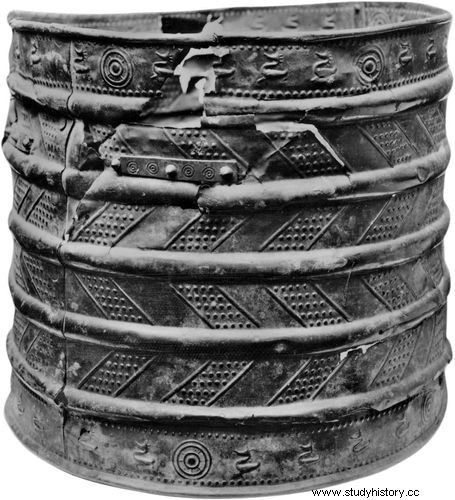Hallstatt , location in Upper Austria's Salzkammergut, where objects identified, the ones for the late Bronze Age and the early Iron Age (from approx. 1100 v . Ch. ) Characteristic are; the term Hallstatt now generally refers to the culture of Late Bronze and Early Iron Age in center and Western Europe . During excavations between 1846 and 1899, more than 2,000 graves were found in Hallstatt. The majority fall into two groups, an earlier ( approx. 1100/1000 to approx. 800/700 v . Ch. ) and a later one ( approx. 800/700 to 450 v . Ch. ). Near the Graveyard there was a prehistoric salt mine . Due to the preservative nature of salt, Devices , clothing, and even the bodies of the miners themselves.

Hallstatt remains are generally divided into four phases (A, B, C, and D), although among scholars there is some disagreement as to how to date these phases. In phase A, iron was rare, but Villanovan ( see also ) Influences are obvious. Cremation was practiced in cemeteries with shallow graves (or under very low mounds). The ceramic in the southwest Germany was thin-walled, some with strong metallic influence to betrayed, while further east the Silesian influence (Lausitzer B) is noticeable.
Phase B, restricted to the western regions, was characterized by the confirmation of the Old Bronze Age population of south-west Germany over the comparatively new ones urnfield peoples. The Tumulus (carts) became common at burial again, and the Cremation is predominant. The pottery (sometimes polychrome) is very well made.
In phase C, iron was commonly used. Both cremation and inhumation (burial) were used, and the pottery was both polychrome and unpainted. Among the many metal types were:long, heavy iron and bronze swords with scrolled chapels (the metal attachment at the top); the winged Hallstatt axe; and long bronze belt mounts.
Phase D will not be represented in the East area Austria but it took time for the to appear La Tene ( QV ) time in other areas. The burial rite was mostly inhumation; The pottery that is not common degenerates in style and technique. Among the metal objects depicted were:the "horseshoe" or antenna-hilt dagger sword; a variety of brooches and ring ornaments; and belt mounts, sometimes in pierced work . Early archaic Greek ships appear to the west.
Hallstatt art is generally highly geometric; The progress made was more technical than aesthetic Nature. There is a general tendency towards the extravagant and baroque, and the influence of Greek orientalization is barely noticeable. The typical bird motif, probably from Italy , can perhaps be traced back to the late Helladic period in Greece. Plant patterns are very rare, although color contrasts and the breaking up of smooth surfaces were often used. The arrangement of the figures in pairs is very characteristic; However, the designs seem to be concerned with rigid symmetry rather than treating the arrangement as an organic whole.
